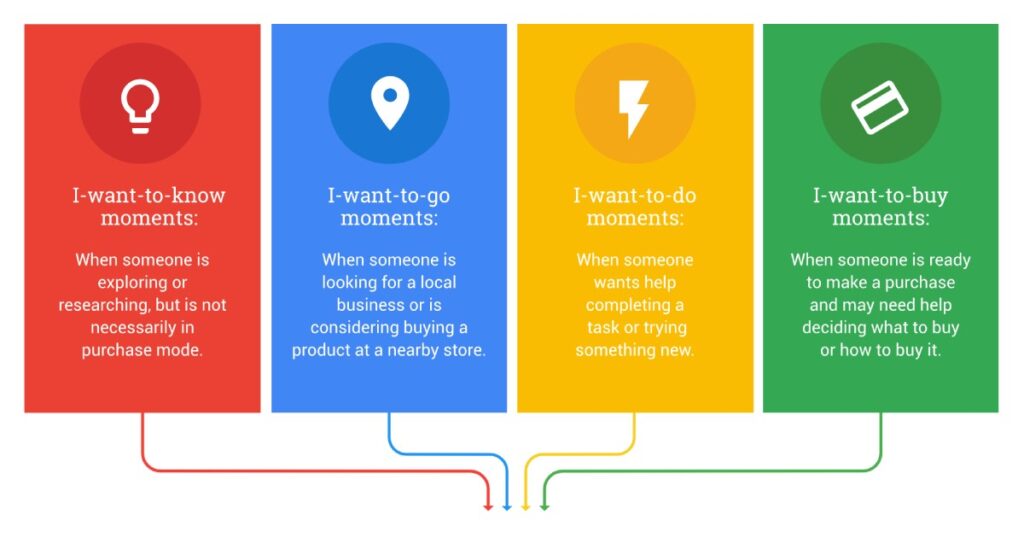In today’s fast-paced digital world, users turn to search engines to fulfill immediate needs. Google defines these intent-driven searches as micro-moments, where consumers expect fast, relevant, and helpful answers. To build a successful SEO strategy, businesses must align their keyword targeting and content strategy with these micro-moments to capture and convert potential customers.
Understanding Micro-Moments in SEO
Google has identified four key micro-moments that drive consumer behavior:
- I-Want-to-Know Moments – Users seek general information or research answers.
- I-Want-to-Go Moments – Users look for nearby businesses or services.
- I-Want-to-Do Moments – Users search for step-by-step guides or tutorials.
- I-Want-to-Buy Moments – Users are ready to purchase and need product recommendations or comparisons.
By structuring your SEO strategy around these micro-moments, you can improve search visibility, enhance user experience, and increase conversions.
1. SEO for I-Want-to-Know Moments (Informational Searches)
User Intent: Consumers are in the early stages of research and looking for valuable insights or answers to their questions.
Keyword Strategy:
- Focus on long-tail keywords and question-based search queries.
- Examples: “What is the best running shoe for beginners?”, “How does digital marketing work?”
SEO Tactics: ✅ Create high-quality blog posts and pillar content answering common industry questions. ✅ Optimize FAQ pages with schema markup for featured snippets. ✅ Use internal linking to guide users to relevant resources. ✅ Leverage YouTube SEO by creating educational videos targeting these queries.
2. SEO for I-Want-to-Go Moments (Local & Navigation-Based Searches)
User Intent: Users are looking for businesses, stores, or services in their immediate area.
Keyword Strategy:
- Focus on geo-targeted keywords and “near me” searches.
- Examples: “Best coffee shop near me”, “24-hour pharmacy in London”
SEO Tactics: ✅ Optimize your Google My Business (GMB) profile with accurate information. ✅ Implement local SEO tactics, including NAP consistency (Name, Address, Phone Number) across directories. ✅ Use Google Maps integration and add location-specific content to your website. ✅ Collect and respond to customer reviews on Google and other review platforms.
3. SEO for I-Want-to-Do Moments (Instructional & DIY Searches)
User Intent: Users need step-by-step guidance on how to complete a task.
Keyword Strategy:
- Focus on “how-to” queries, tutorials, and step-by-step guides.
- Examples: “How to bake a chocolate cake”, “DIY home office setup”
SEO Tactics: ✅ Create detailed blog posts and instructional videos. ✅ Use structured data markup to qualify for featured snippets. ✅ Develop interactive content like checklists, calculators, or downloadable guides. ✅ Repurpose content into Pinterest infographics or YouTube tutorials for additional reach.
4. SEO for I-Want-to-Buy Moments (Transactional & Purchase-Intent Searches)
User Intent: Users are ready to make a purchase and are looking for product details, reviews, or deals.
Keyword Strategy:
- Focus on high-intent commercial keywords like “best,” “buy,” “discount,” and “review.”
- Examples: “Best wireless headphones 2025”, “Buy electric scooter online”
SEO Tactics: ✅ Optimize product pages with clear CTAs, detailed descriptions, and high-quality images. ✅ Include customer reviews and comparison charts to build trust. ✅ Use SEO-friendly meta titles and descriptions with persuasive language. ✅ Run Google Ads & Shopping Ads targeting high-intent keywords. ✅ Implement structured data for product schema to improve visibility in search results.
Integrating Micro-Moment SEO Across Digital Channels
A successful SEO strategy goes beyond website optimization. Businesses should integrate micro-moment targeting across all digital marketing efforts:
📌 Social Media SEO: Share micro-moment-aligned content, including informative posts, local promotions, how-to videos, and product highlights. 📌 Email Marketing: Segment audiences based on intent and deliver relevant content tailored to their search behavior. 📌 Paid Search & Display Ads: Use micro-moment-based ad campaigns to reach consumers at the right time. 📌 Voice Search Optimization: Optimize content for conversational queries as more users rely on voice search.
Final Thoughts
Aligning your SEO strategy with Google’s micro-moments helps you deliver the right content at the right time, ultimately driving organic traffic and increasing conversions. By identifying which micro-moments matter most to your business and optimizing your content accordingly, you can build a stronger search presence and improve customer engagement.
Ready to enhance your SEO strategy? Start by analyzing your audience’s search behavior and integrating micro-moment SEO into your marketing efforts today!


